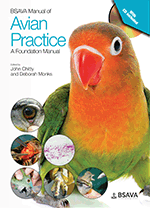
Full text loading...

Malnutrition is responsible for up to 90% of pet bird disease, and is the most common cause of death in pet parrots. To correct the problems that lead to avian nutritional disease the veterinarian needs an understanding of the issues that promote malnutrition. This chapter takes a holistic approach to the principles of nutrition.
Nutrition, Page 1 of 1
< Previous page | Next page > /docserver/preview/fulltext/10.22233/9781910443323/9781910443323.6-1.gif

Full text loading...





